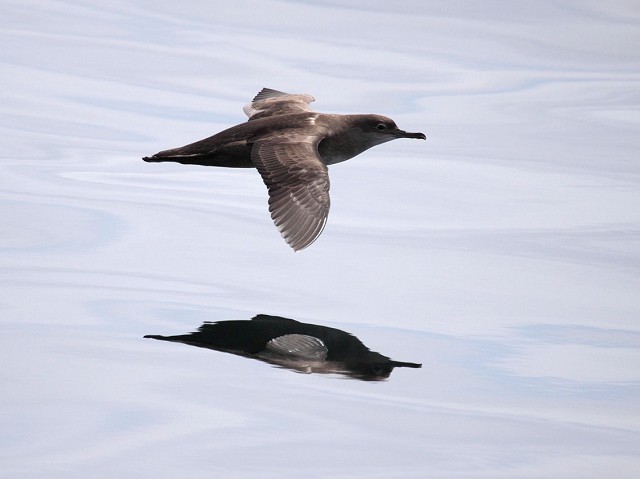EU plan launched to halt seabird killing after decade-long campaign
Today [Friday 16th November 2012], after a long fight, the European Commission has finally launched an EU Plan of Action to reduce seabird bycatch: the incidental deaths of seabirds ensnared in fishing gears. The RSPB and its EU partners have called for an action plan since 2001, when the European Commission first committed to proposing one. Since then, we estimate that over two million seabirds have died in the fishing gear of vessels in EU waters alone, not counting the additional impact of EU-flagged vessels operating in the southern oceans where bycatch is held mainly responsible for 17 out of 22 albatross species being threatened with extinction.
Martin Harper, Director of Conservation, said, "We applaud the EU for finally calling time on the needless deaths of seabirds. The RSPB is ready to work together with fishing communities to put the plan into action both here and abroad. However, the plan is essentially voluntary and to have real teeth it needs to be underpinned with legally binding measures under the Common Fisheries Policy1, in particular to require fishing boats to use the technical fixes known to avoid catching birds, and to collect data on seabird bycatch."
The EU Seabird Plan of Action aims to minimise and, where possible, eliminate the bycatch of seabirds in EU and external waters. It sets out to achieve this through a range of actions, notably calling on vessels to apply mitigation measures to prevent seabirds coming into contact with fishing gears. Other key areas cover research and development, and awareness-raising and training for fishermen. The RSPB considers the plan to be best practice, drawing heavily on other regions of the world where non-EU fleets have already embraced the often simple solutions proven to stop seabirds being killed. In the example of longline fishing, numerous studies from around the world demonstrate that simple but effective measures to deter seabirds from snatching bait from hooks and becoming ensnared can increase the vessel's fish-catching efficiency, creating a 'win-win' situation for fishermen and seabirds. Bait is expensive so its loss to seabirds is a financial cost and, in addition, every hook that sinks without bait is a potential fish not caught.
Of the species that are heavily affected by bycatch in European waters, three occur regularly in the UK. All three are cited as threatened with global extinction, with seabird bycatch being listed as a major threat. The Balearic Shearwater visits the English Channel and South Western Approaches regularly in autumn and winter, while the Velvet Scoter and Long-tailed Duck regularly winter along the UK's North Sea coast.

Balearic Shearwater, at sea, Cornwall (Photo: Phil Wallace)
Euan Dunn, Head of Marine Policy at the RSPB, stated, "Seabirds are among our most visible and iconic indicators of ocean health, and experience tells us that responsible fishermen would much rather catch fish than birds, if only they had the means to do so. This desperately overdue EU Seabird Plan of Action now gives Member States and the fishing industry a golden opportunity to do that, and we trust they will seize it. For the most threatened species like Balearic Shearwaters there is no time to waste, so we need emergency action to tackle their fatal attraction to fishing gear."
In EU waters, most seabird bycatch arises from gillnets and longlines, but to a lesser extent also trawls and purse seine nets. At least 100,000 birds are killed every year in gillnets in the Baltic Sea and eastern North Sea. A Spanish longline fishery for hake off southwest Ireland is estimated to kill tens of thousands of seabirds annually, mostly Great Shearwaters. This slaughter flies in the face of the EU Birds Directive which is meant to protect European seabirds, including globally threatened species, that are caught and drowned in EU fishing gears.
It is therefore a vital first step that the Seabird Action Plan has finally seen the light of day. Following the European Commission's proposal, it will be up to Member States to endorse the plan in Council, and then to translate it into effective measures in their national waters and also on the high seas, governed by the Tuna Commissions2, where EU-flagged vessels also roam.
Useful links
EU Plan of Action to reduce seabird bycatch
International Union for Conservation of Nature (IUCN) Red List
Footnotes
1 Common Fisheries Policy: the EU Common Fisheries Policy (CFP) sets catch limits for the UK and other EU Member States on what type of fish and how much they are allowed to catch, as well as encouraging the fishing industry by various market interventions. The CFP is also committed to take an 'ecosystem approach' to fisheries management, which includes avoiding adverse impacts on non-target species like seabirds. In July 2011, the European Commission presented its proposals for the reform of the CFP; negotiations to complete this are ongoing.
2 The Tuna Commissions are formally called Regional Fisheries Management Organisations (RFMOs). EU — especially Spanish — vessels fish under licence for tuna and swordfish in several RFMOs, notably ICCAT (International Commission for the Conservation of Atlantic Tunas) and IOTC (Indian Ocean Tuna Commission).

